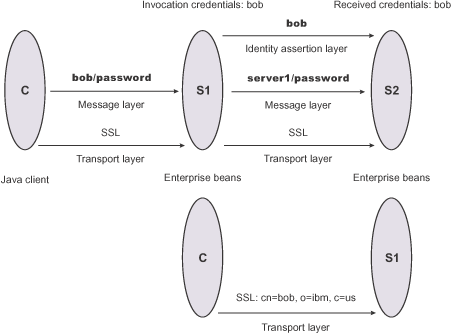

This scenario is the same as Scenario 1, except for the interaction from client C2 to server S2. Therefore, the configuration of Scenario 1 still is valid, but you have to modify server S2 slightly and add a configuration for client C2. The configuration is not modified for C1 or S1.
Configuring client C2
Client C2 requires transport layer authentication (Secure Sockets Layer (SSL) client certificates). To configure transport layer authentication:
All further configuration involves setting properties within this file.
com.ibm.CSI.performTransportAssocSSLTLSSupported=true,
com.ibm.CSI.performTransportAssocSSLTLSRequired=false
com.ibm.CSI.performClientAuthenticationRequired=false,
com.ibm.CSI.performClientAuthenticationSupported=false
com.ibm.CSI.performTLClientAuthenticationRequired=false,
com.ibm.CSI.performTLClientAuthenticationSupported=true
Configuring server, S2
In the administrative console, server S2 is configured for incoming requests to SSL client authentication and identity assertion. Configuration for outgoing requests is not relevant for this scenario.
Related reference
Scenario 1: Basic authentication and identity assertion
Scenario 3: Client certificate authentication and RunAs system
Scenario 4: TCP/IP transport using a virtual private network
Scenario 5: Interoperability with WebSphere Application Server Version 4.x
Example: Common Security Interoperability Version 2 scenarios